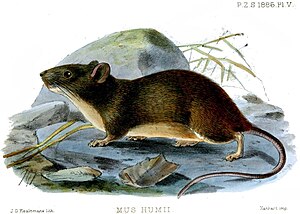Manipur Bush Rat: Species of mammal
The Manipur bush rat (Latin: Hadromys humei, Meitei: Naarakki Uchi) or Hume's rat or Hume's hadromys is a species of rodent.
It belongs to the family Muridae. It is found in Manipur and other Northeastern Indian regions. It is an endangered species.
| Manipur bush rat | |
|---|---|
 | |
| Scientific classification | |
| Domain: | Eukaryota |
| Kingdom: | Animalia |
| Phylum: | Chordata |
| Class: | Mammalia |
| Order: | Rodentia |
| Family: | Muridae |
| Genus: | Hadromys |
| Species: | H. humei |
| Binomial name | |
| Hadromys humei (Thomas, 1886) | |
| Synonyms | |
| Mus humei, Mus humii | |
Home
The species lives only in Northeast India. It has been recorded from several localities. These are:
- Bishnupur in Manipur
- Imphal in Manipur
- Senapati in Manipur
- Karong (specimen FMNH 76562) in Manipur.
- Angarakhata in Kamrup district (Assam)
The Manipur bush rat lives at places with medium altitudes from 900 to 1,300 m (3,000 to 4,300 ft) above sea level. It lives in tropical evergreen, moist deciduous and evergreen forests. It is also found in secondary forests in Northeastern India.
Finding out
The murid was described by Oldfield Thomas in 1886. The description was from specimens in the Manipur collection of Allan Octavian Hume. It was donated to the British Museum (Natural History) after Hume's life's work in ornithological notes were sold by a servant as waste paper. The Manipur Bush Rat was named in honour of him. The collection has two male and two female specimens. It was recorded to be collected on 23 March 1881 from Moirang in Manipur. It was the type locality for this species.
Description
The specimen has been described by Thomas (1886) as:
General colour above exceedingly like that of Golunda ellioti, Gr., viz. coarsely grizzled grey, lightest on the head and graduallv turning to deep rufous on the rump, the tips of the great majoritv of the hairs being white or yellowish white on the head and fore quarters, and gradually becoming rich rufous on the hind quarters, their bases in all cases deep slaty -blue. The other hairs are black throughout, and form the black element in the general grizzling. Sides like the forequarters. Belly yellow or orange, mixed with the slate of the haii -bases; no black-tipped hairs below. The inner sides of the thighs and all round the base of the tail rich rufous. The fur throughout is soft, and unmixed with flattened or spinous bristles. Feet grizzled yellowish white. Ears thinly covered outside with black hairs, and inside with black and yellow or red ones; an indistinct tuft of orange-tipped hairs iu front of the basal notch. Tail well haired, but not pencilled, markedly bicolor, the hairs black above and white below, but the scales, even of the lower side, are uniformly brown. Ears large and evenly rounded, with a small projection in the middle of their inner margins; laid forward they reacli to the posterior corner of the eye. Tail about as long as the body without the head. Fifth front toe unusually short, its claw barely reaching to the bottom of the division between the 2nd and 3rd toes, giving the foot, at first sight, the appearance of being only provided with three toes. Fifth hind toe reaching just to the base of the fourth. Foot-pads 5-6. Mammae 8, 2 pectoral and 2 inguinal pairs.
The length of the head and the body of the largest specimen was that of a female. It was 125 millimetres (4.9 in) long. The length of its tail was 106 millimetres (4.2 in) long. Elsewhere, the head and body length has been given as head and body length as 95 to 140 millimetres (3.7 to 5.5 in), the tail length as 195 to 40 millimetres (7.7 to 1.6 in). The weight has been recorded as ranging from 41 to 77 grams (1.4 to 2.7 oz).
Safeguarding level
The species has been given safeguarding level (conservation status) of "Endangered - B1ab(iii)+2ab(iii)" in IUCN Red List ver 3.1. The rules for this rating include:
- maximum area of living (less than 500 km2 (190 sq mi)).
- maximum geographical area of span (less than 5,000 km (3,100 mi)).
- less than five reported areas.
- continuing decline in areas and destruction of homes.
The main causes of damages to the conditions of this species are found to be loss of and destruction of home, separation, and overpass. Other than these, hunting and firing are also the contributing causes.
References


This article uses material from the Wikipedia Simple English article Manipur bush rat, which is released under the Creative Commons Attribution-ShareAlike 3.0 license ("CC BY-SA 3.0"); additional terms may apply (view authors). Content is available under CC BY-SA 4.0 unless otherwise noted. Images, videos and audio are available under their respective licenses.
®Wikipedia is a registered trademark of the Wiki Foundation, Inc. Wiki Simple English (DUHOCTRUNGQUOC.VN) is an independent company and has no affiliation with Wiki Foundation.
